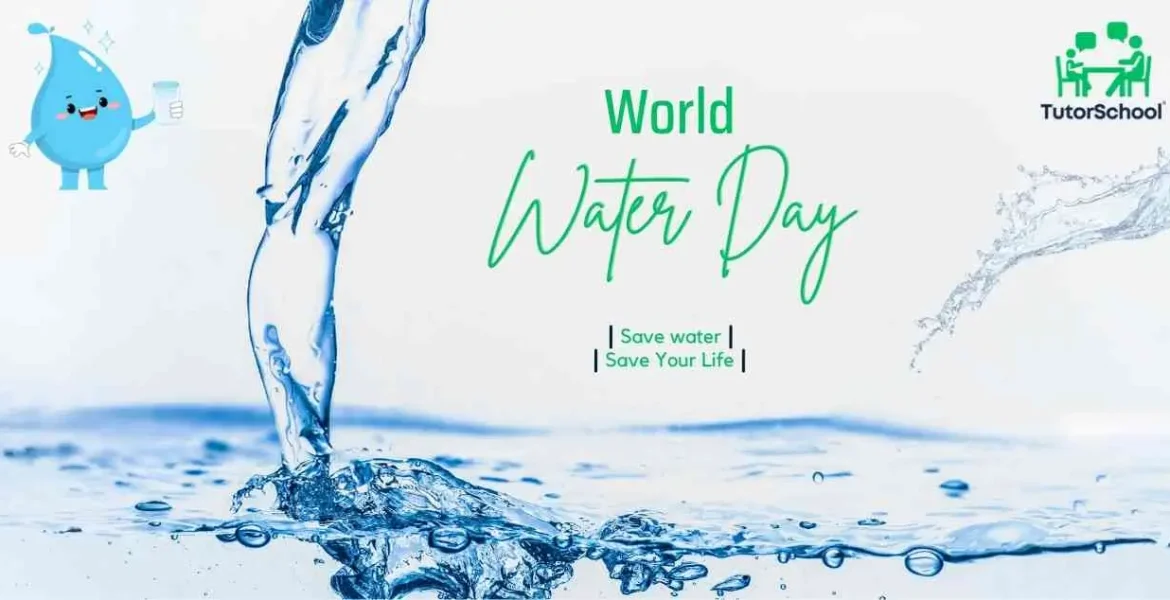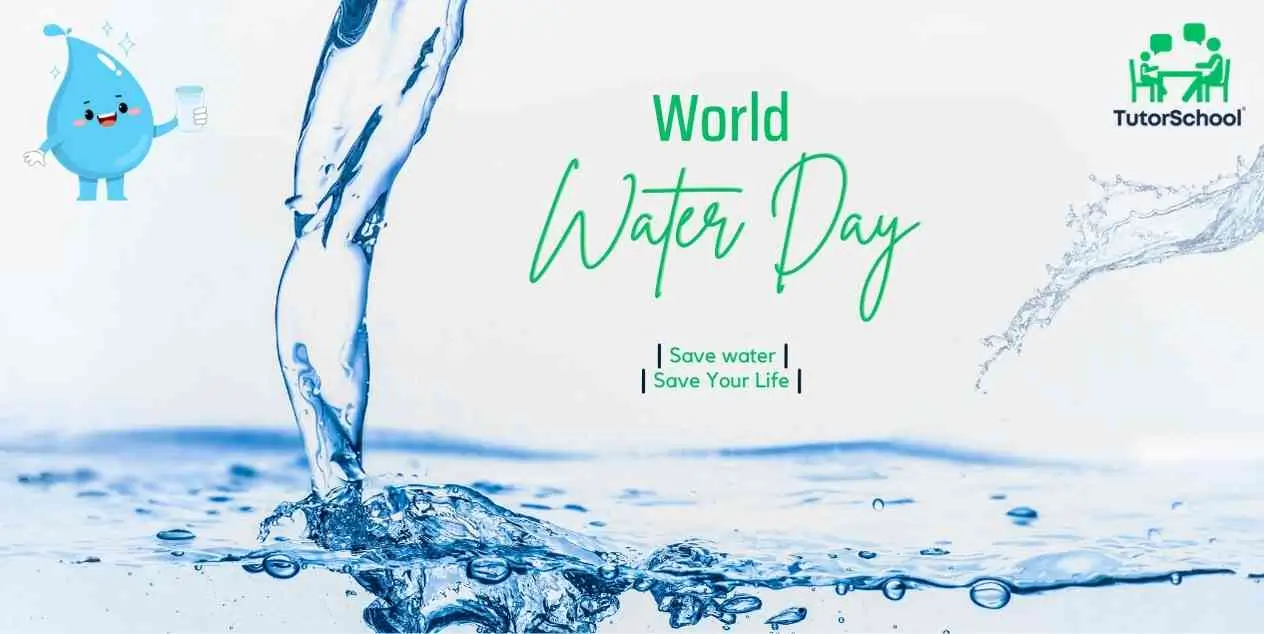World Water Day 2025 | Explore The Complete Guide In Details
Written By: Mehika Content Writer @ Tutorschool
March 28, 2025

“ Don’t let the water run into the sink, our lives are on the brink! ”
It truly is, which is why water is called an elixir. Water is used in our daily chores, such as bathing, cooking, cleaning, and the list is endless. Our Earth has about 97% saltwater, 68% trapped in ice and glaciers, 3% fresh water, but less than 1% water is available for human use. Now you get why water is referred to as treasure and should we save it?
World Water Day – Origin & Objectives
The United Nations General Assembly designated March 22nd as World Water Day in 1993. Since then, each year is celebrated as World Water Day, wherein the United Nations and its member states implement and promote specific initiatives within their countries. It highlights the importance of conserving and protecting water, a vital resource for the health of people and the environment. World Water Day celebrates water and raises awareness about people living without access to safe drinking water. According to the United Nations, approximately 2.2 billion people still lack access to pure drinking water and thus are forced to drink contaminated water.
March 22nd is celebrated as World Water Day to address the global water crisis and achieve the Sustainable Development Goal of ‘Clean Water and Sanitation.’ The significance of World Water Day lies in its ability to arouse global attention and inspire meaningful change. Water Day acknowledges the progress made in saving water and the work yet to be done. Activities for World Water Day and other days can range from educational workshops, community clean-up drives, campaigns, turning off the tap while brushing or shaving, fixing leaks, taking shorter showers, collecting rainwater, etc.
The impact of climate change further exacerbates the water crisis, leading to more frequent and intense droughts and floods. World Water Day has to address the critical link between water security and climate resilience.
Theme of World Water Day 2025
This year, World Water Day’s theme is ‘Glacier Preservation’, emphasizing the importance of ice, snow, and glaciers in the water cycle. Glaciers are frozen rivers that allow freshwater to flow. They store nearly 70% of Earth’s freshwater, essential for drinking water, sanitation, agriculture, industry, and the production of clean energy. Due to heat waves and high temperatures, summers are longer while winters are shorter. Glaciers store nearly 70% of Earth’s freshwater, a critical resource for drinking water, agriculture, industry, and clean energy production. However, due to rising global temperatures, glaciers in regions like the Himalayas, Alps, Andes, and Arctic are shrinking at an alarming rate, endangering ecosystems and human settlements.
The United Nations has stressed that glacier preservation is a survival strategy, urging governments, industries, and communities to take immediate action. The focus of World Water Day 2025 is to reduce greenhouse gas emissions, implement sustainable water management practices, and promote international cooperation to safeguard glaciers and the freshwater reserves they provide.Various events were organized to celebrate Water Day around the world. For instance,a two-day event at United Nations Educational,Scientific and Cultural Organization(UNESCO) Paris, featured brainstorming and debate sessions on the decade of action for cryospheric sciences, high level talks and presentations of “United Nations World Water Development Report 2025: Mountains and Glaciers – Water Towers.”
Organizations like “Twinkl” provided educational resources to help students and other people understand the importance of water and glaciers. Moreover,”National Great Rivers Research and Education Centre” hosted photo contests and exhibitions to showcase the beauty and significance of water bodies.
What can we do at ground level?
22 March is celebrated as World Water Day to unify people all across the world to keep water issues at the forefront of global concerns. This day serves as a reminder that the global water crisis is a complex challenge that cannot be solved by a single solution. It requires a collaborative and multi-faceted approach. Collaborations between different stakeholders, like governments, businesses, NGOs, and community groups, are crucial for creating impactful and sustainable solutions to conserve water. The focus should be beyond just access to water; it should encompass water quality, management and protection of water resources.
Activities for World Water Day can include fundraising for water projects, schools can teach students about water conservation, the government can implement robust policies, improve water infrastructure, ensure equitable access and engage a wider audience to communicate the importance of water.
Access to safe water and sanitation is a fundamental right. Small collective actions can lead to significant differences. Water day calls for action for a more secure future. The theme for World Water Day 2024 was ‘Leveraging Water for Peace.’ This highlighted the instrumental role water plays in preventing conflicts and fostering cooperation. It draws attention on how water scarcity and unequal access can lead to tensions, while collaborative water management can build trust and promote peace.
Let us check the status of water in India, which is home to 1.4 billion people, and faces a severe water crisis. According to reports, around 35 million people lack access to safe drinking water, while 678 million people lack access to proper sanitation. The country’s growing population, urban expansion, and erratic rainfall patterns contribute to worsening water scarcity. Despite having 18% of the world’s population, India has only 4% of global freshwater resources. The water status in India is alarming due to:
- Severe groundwater depletion in several regions.
- Pollution of surface and groundwater sources.
- Unequal water distribution, with some areas facing floods while others experience droughts.
Some water challenges are :
- Groundwater depletion is worsening, especially in states like Punjab, Haryana, and Rajasthan.
- Poor water quality, with 70% of India’s water being contaminated.
- Inefficient irrigation methods lead to excessive water wastage.
- Climate change impacts, causing erratic monsoons and prolonged droughts.
Challenges all over the world :
- Rivers, lakes, and oceans are marred by the sight of plastic bottles, wrappers, and other debris, not only tarnishing their appearance but also endangering the flora, fauna, and human communities reliant on them.
- Industrial, agricultural, and household pollutants seep into water bodies, rendering them unsafe for consumption and detrimental to aquatic ecosystems.
- Similar to leaving a faucet running endlessly, some regions worldwide are depleting water resources faster than they can regenerate, leading to shortages and dried-up riverbeds.
- Agricultural irrigation, industrial processes, and daily human consumption cumulatively strain water resources, exacerbating the imbalance between usage and replenishment.
- Rising temperatures and erratic rainfall patterns contribute to more frequent and severe droughts, shrinking water sources and amplifying water scarcity issues.
- While some areas face prolonged droughts, others contend with heightened rainfall and flooding, posing challenges such as soil erosion and water source contamination.
- While many enjoy instant access to clean water, millions globally lack this basic necessity, often having to travel long distances to fetch water that may still be unsafe for consumption.
- Inadequate access perpetuates a cycle of poverty and ill health, as contaminated water sources contribute to widespread illness and disease burden.
- Infrastructure projects like dams and river diversions intended to meet human water needs can disrupt ecosystems, endangering plant and animal species reliant on those water sources.
Conclusion
Water is an indispensable form of life.However, climate change and pollution are depleting freshwater resources. World Water Day, an initiative by the United Nations advocates for sustainable water management and aspires to achieve Sustainable development goal 6 by 2030 for all. By understanding the importance of water and conserving it wisely, we can assure a healthier and a prosperous future for all!
FAQs
1. What is the theme for World Water Day 2025?
The theme for this year’s water day is “Glacier Preservation.” For more details, you can visit the UN website.
2. What are key points of World Water Day?
Water Day is celebrated on March 22nd every year, marking the significance of freshwater resources. It promotes awareness among citizens to save water for the present and future generations to come. It also states methods for conserving water and gathers people from every corner of the world to save water to save our life.
3. Who started World Water Day?
World Water Day was started by the United Nations Conference on Environment and Development (UNCED) in 1992 in Brazil. The first celebration of Water Day in the world was held in 1993.
4. What is water?
Water is a liquid formed by hydrogen and oxygen (H₂O). It covers 71% of the Earth’s surface and takes the form of ice, gas, and liquid.
5. What is the main symbol of World Water Day?
World Water Day does not have a universally standard symbol, but some signs that can be used are the United Nations logo, a water droplet with a globe, white doves and peace symbols, and holding hands with a water droplet and a heart.
6. Why should we save water?
We should save water because it is necessary for our survival. It is used to quench thirsts, regulate body temperatures, bathe, for agriculture, and industry. It is also needed for supporting biodiversity and the functioning of natural habitats.
